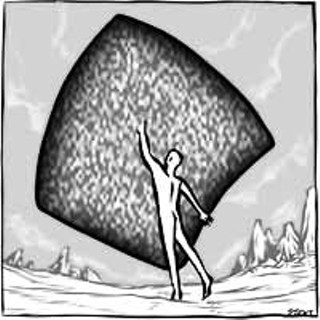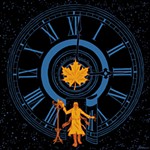Letters at 3AM
The World Is No Longer the World
By Michael Ventura, Fri., March 3, 2000

Robert W. Taylor isn't a widely known name, but he was crucial in the development of the Internet. First at NASA and then at the Pentagon's Advanced Research Projects Agency (ARPA), he, Douglas C. Englebart, and J.C.R. Licklider, began developing the ideas and inventions that would lead to the Internet's precursor, ARPA-net, in 1969. Taylor also sponsored Englebart's development of the mouse (for NASA), windows, and networking -- all of which were demonstrated as early as 1968. Their innovations created the foundation for the Internet as we know it today. So when Robert W. Taylor speaks of the future, we'd best listen. Last December, in an interview with The New York Times, he was asked how the new broadband technologies would impact daily life. He answered: "You'll be able to wear -- an unobtrusive device that will record in full color and sound everything that you see or point your head at, or, depending on how many of them you have, everything that's around you. And share it. Every waking and sleeping moment in your life will be recorded. And you will be able to store and retrieve it and do what you will with it." (He added, almost as an afterthought, "there are obvious implications for privacy that will have to be worked through.") "How will that change the world?" the interviewer quickly asked. "I don't know," Taylor said, "but it will."
Every waking and sleeping moment -- but of course after only one day of life-recording, you would fall hopelessly behind your ability to manage and manipulate your material. There would not be enough waking moments on the following day for viewing the entire record of the first day -- though one could no doubt fast-forward. Still, much of the second day would be images of the person viewing the previous day's images -- mirrors facing mirrors. That's one possibility. Or, instead of letters, you could e-mail hours of your life as you'd lived it -- probably as you're living it! Or two people who'd spent the day (or night) together could run both records simultaneously on a split screen. Or maybe you'd set up a Web site on which, every day, you'd run your life of the previous day (or again, Web site it live!) -- instant replay might become a kind of learning aid to one's sense of identity, proof that you exist in a world that no longer entirely believes in any reality that can't be contained on a screen. Western civilization has already and thoroughly defined "life" as "self-consciousness," "I think therefore I am," but this technology would create an environment in which the recorded consciousness of a life would be defined strictly in terms of what could be seen and heard -- reality increasingly is defined as information, rather than as our consciousness of information.
One interesting thing is that the person recording life with the technology that Taylor predicts would be invisible in his or her own record except when looking in mirrors -- the "unobtrusive devices," as envisioned by Taylor, face outward; to see oneself you'd have to see someone else's record. But they'd quickly find a way around that design flaw. For the general idea seems to be that you, in particular, are the center of the universe --or can at least create the technological facsimile of what it would look like if you were the center of the universe, and then you could confuse fantasy and reality at will. As usual.
The possible permutations are dizzying. If what I've described seems far-fetched, remember that 100 years ago "leisure time" was defined by activity -- for instance, nearly every neighborhood, town, and workplace had its own baseball team; those people would have thought it very far-fetched that in a few short years most Americans would be content to spend their leisure watching actors engage in make-believe activity on screens.
No doubt my ruminations on Robert W. Taylor's predictions are primitive -- an expression of my own mindboggledness. But whether or not his prediction comes true, that the possibility is real says much about the progression of our perception of the human image. To get perspective it may be helpful to review the modern history of the self-image.
Before photography, the human image was viewed selectively, to say the least. Paintings were of gods, the aristocracy, the rich, and the famous. And the vast majority of people never saw a painting -- in fact, except for public statuary, most people rarely saw a representation of what anybody looked like, much less what they themselves looked like.
All this changed in America when the Civil War began in 1860. There was a sudden and enormous market for personal photographs -- many were taken of Civil War soldiers for families back home. Photographers traveled with the armies. Personal photographs became and remained a part of life for all levels of society. Most of those images were solemnly staged -- it is rare to find a 19th-century photo of somebody smiling; it was still a solemn thing to see ourselves, study ourselves, compare our image with others -- but the human image was no longer the privilege of the privileged.
The motion-picture camera was, after this, a psychoactive experience. Again, it is hard now to imagine the impact of the film The Great Train Robbery in 1903. When the screen cowboy shot his pistol at the audience, there were instances of viewers pulling their guns and shooting back. When the train came straight at the camera, looming larger and larger, often people screamed and ducked and fled. A screen close-up was bigger than any image of any face that anyone had ever seen -- movies instantly became something everyone had to see, because at last they were seeing life as they felt it, as it reverberated in their fantasies, in their privacies, in their sense of intimacy and their sense of themselves. The popularity of live theatre quickly and drastically dwindled because only the greatest actors could equal in intensity the instantaneous dream-like intimacy of film, and no stage could match cinema's epic sweep -- no one ever said of a play what President Woodrow Wilson said of D.W. Griffith's Birth of a Nation in 1915: "It is like seeing history lit by lightning." Then in London in 1926 the Scottish inventor John Logie Baird -- without funding, and using mostly scrap materials -- achieved the first transmission of television images. In a mere 25 years (just a little longer than it took for the Taylor-Englebart-Licklider computer innovations to take hold), televisions would become common household appliances. So --
In just 90 years, from roughly 1860 to 1950, the human image went from being a rare artifact to a common and solemn still photograph viewed (mostly) in the home, to a dream-like and incendiary moving picture seen in dark public rooms, to domesticated moving pictures experienced intimately (in the home) but on a mass scale (in many homes at the same time) -- thus our fascination with viewing the human image transformed the home from a private place to which only family and intimates were invited, to an outlet of mass communication and mass markets in which the whole world was invited. By 1990 the Internet and the PC made the screen a permeable membrane through which you could send as well as receive, until now Internet traffic is said to be doubling every 95 days, with Americans adding two million pages to the Web daily. Thomas A. Friedman in The New York Times on February 11, 2000: "When Bill Clinton was elected president seven years ago there were 50 pages on the Word Wide Web. Today there are over 50 million. In 1992 no one had ever heard of e-commerce. This year retail e-commerce alone in the U.S. will hit $50 billion." And now Robert W. Taylor envisions a technology that may blend daily life with the screen and the Web such that cyberspace may become a more physically intimate space than anything we've ever imagined. Which is quite a trick for something so non-physical we have to call it "virtual."
For cyberspace, which definitely exists, hasn't the properties of what we normally think of as physical existence; yet it already has become the great repository and recorder of physical existence. This is a fact so obvious, so all-encompassing, and such a reversal of everything humanity has ever known, that we've gotten very good very quickly at taking it for granted. We've had to. Because physical existence is fragile enough; to depend so much, to stake so much of our identity, on virtual existence, increases both the power and the precariousness of individual life. The physical world is no longer "the world."
That is the greatest transformation in history. And there is no fit expression for it. Words were always crude tools to express our lives; now, for the expression and description of this life, words are coming to resemble stone implements.
And Robert W. Taylor predicts that this condition is about to expound exponentially beyond even his vision. "How will that change the world?" "I don't know, but it will." ![]()








